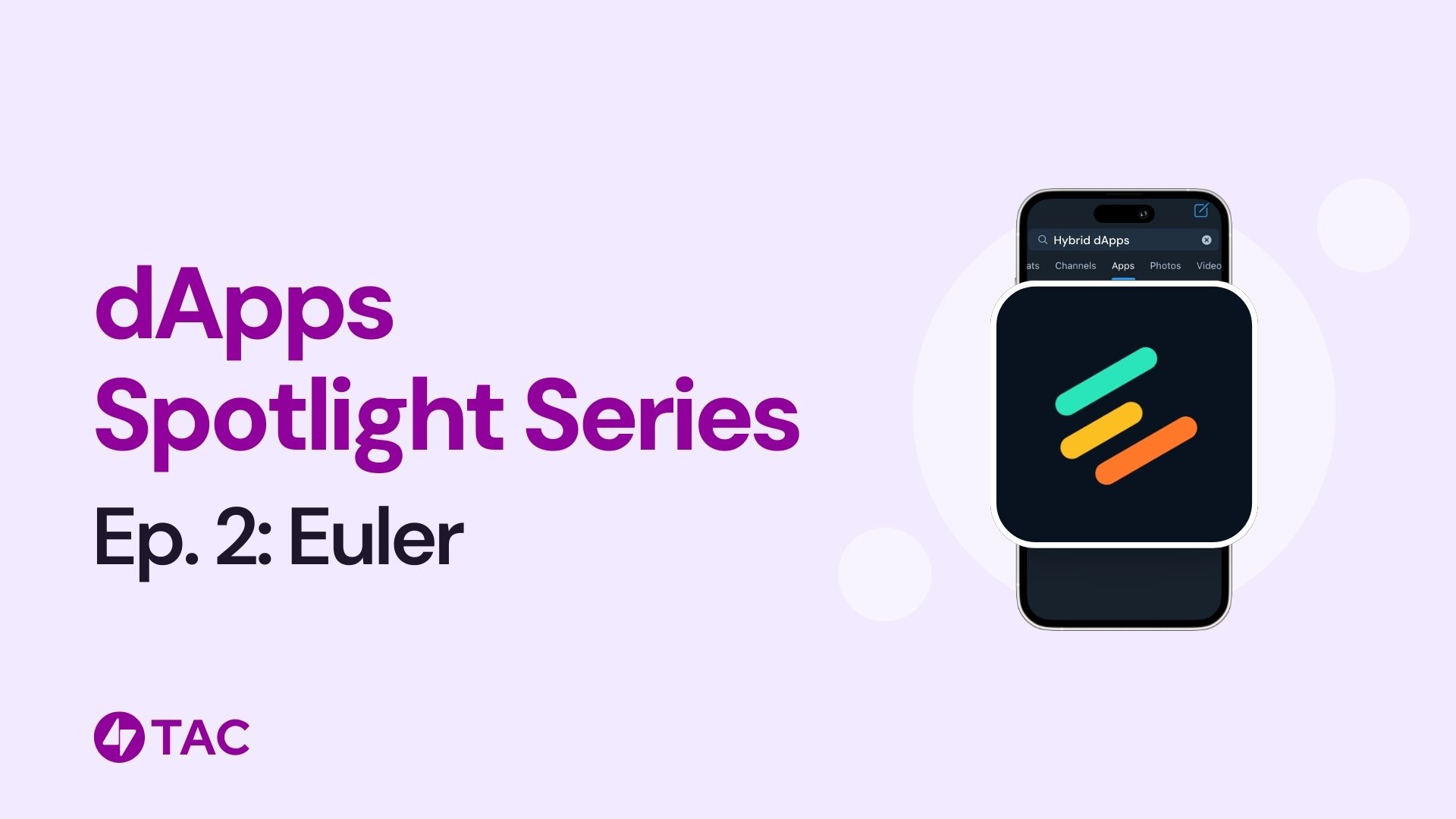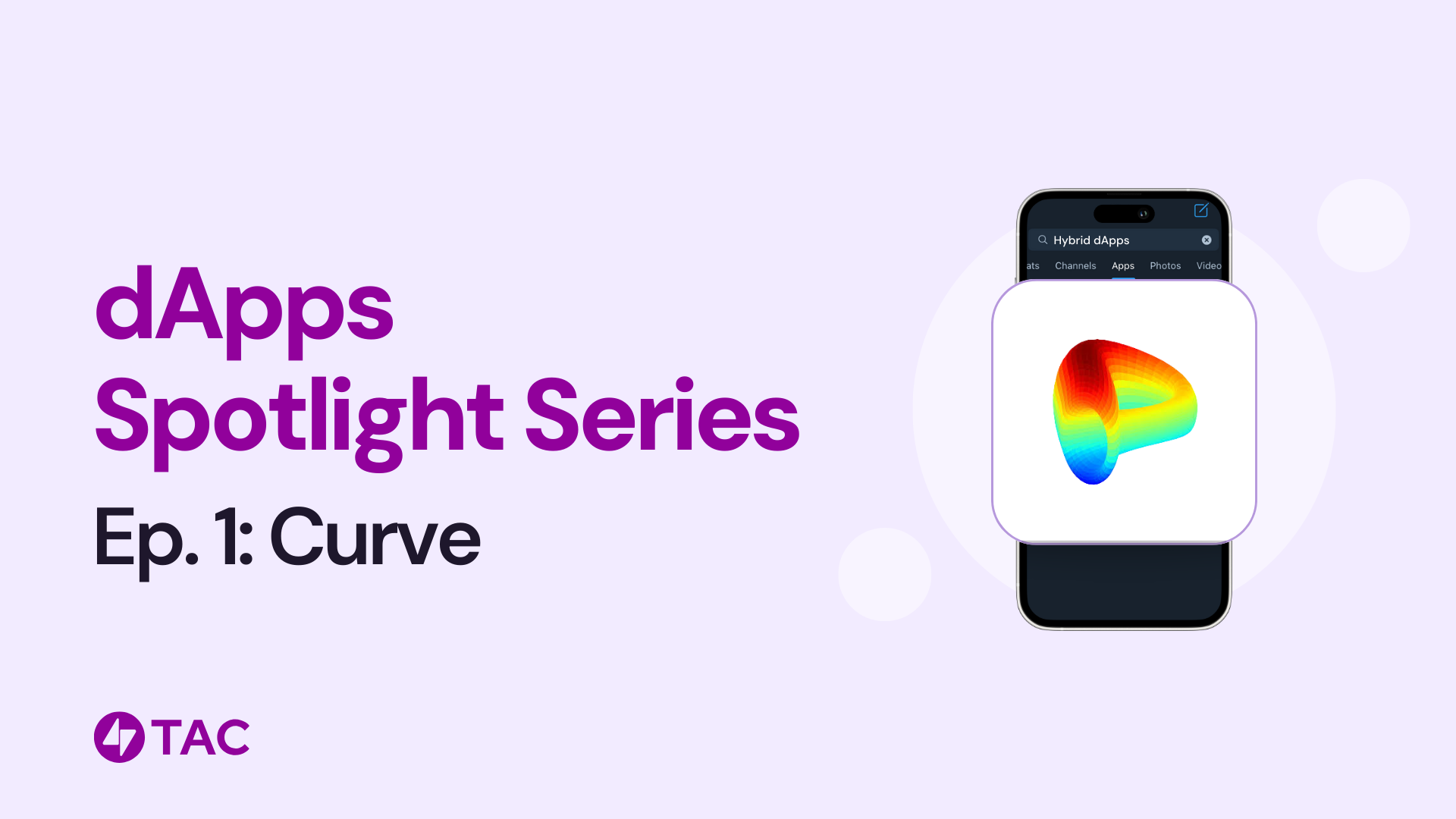TAC Protocol is launching its native token $TAC, marking a major milestone in TAC’s mission to bridge Ethereum’s decentralized application ecosystem with Telegram’s massive user base. TAC is designed to extend The Open Network's (TON) DeFi ecosystem by bringing sophisticated and efficient EVM-based dApps and assets directly into the Telegram platform. This strategy aims to take DeFi mainstream by leveraging the distribution power of Telegram's MiniApp framework to its vast user base.
TAC is a first-of-its-kind Layer-1 blockchain that brings Ethereum Virtual Machine (EVM) DeFi and a whole new Yield layer into The Open Network (TON) and the Telegram platform. By leveraging a unique architecture tightly integrated with TON, TAC enables developers to deploy EVM-powered Hybrid dApps and access nearly one billion Telegram users, without those users ever leaving the familiar Telegram environment.
More than 15 dApps from the EVM ecosystem, including some of the largest blue-chip DeFi dApps, will be available right from the public TGE, ensuring high network and $TAC token usage activity.
In this article, we outline the $TAC token’s utility, distribution, and economic design, and explain how TAC’s tokenomics capture network-level value while strengthening the TON ecosystem.
$TAC Token Utility and Role in the Network
As the native asset of the TAC Protocol, $TAC is fundamental to every aspect of network operation and value accrual. It embodies the three core utilities of a Layer-1 crypto token: gas fees, security (staking), and governance, similar to other L1 tokens. Below, we outline each utility and how it functions in TAC’s design:
Gas Fees (Network Usage):
$TAC is the exclusive gas token for executing transactions and smart contracts on the TAC EVM. Every transaction processed by TAC consumes a small amount of $TAC as gas. Notably, because TAC is integrated with TON, TON-based users pay $TON for fees, but a part of those fees are ultimately used to buy and spend $TAC in the background. This design mechanism effectively ensures that all dApp activity by TON’s user base generates continuous buy-pressure for $TAC. Over time, adoption of Ethereum’s EIP-1559 fee model can be considered by the TAC community. With EIP-1559, a portion of each transaction fee is burned (removed from circulation), introducing a deflationary counterforce tied to network usage.
Proof-of-Stake Security:
$TAC is a staking token that secures the TAC network via delegated Proof-of-Stake. Validators must purchase and stake $TAC to earn the right to produce blocks and validate transactions, and in return, they collect rewards in the form of transaction fees and newly minted tokens. Regular $TAC holders can delegate their tokens to professional validators, earning a share of staking rewards and helping secure the chain. This crypto-economic security model means the fundamental value of $TAC is tied to the total value locked and activity on TAC – validators are economically incentivized to keep the network safe and performant, and they absorb financial slashing penalties if they act maliciously. By requiring a meaningful $TAC stake, the network ensures that any entity influencing TAC’s consensus has significant skin in the game.
Governance:
$TAC will be the governance token of the TAC ecosystem, empowering holders to participate in decision-making and shape the protocol. Key parameters and initiatives like protocol upgrades, inflation rate adjustments, incentive programs, DAO treasury fund allocations, and grants to developers can be decided by on-chain governance votes by $TAC stakers. In essence, those who hold and stake $TAC gain voting rights over the direction of TAC’s development and ecosystem growth. This aligns the community and token holders with the project’s success, giving them a direct voice in steering growth initiatives (for example, approving liquidity mining campaigns or developer grant programs funded from the DAO treasury). Over time, as TAC’s governance matures, $TAC stakers will effectively control community resources (like the DAO Treasury detailed below) and ensure the network evolves in line with the community’s interests.
Taken together, these utilities mean that $TAC captures value on multiple fronts: network usage, network security, and network governance. Every transaction on TAC uses $TAC on the backend, every validator must lock up $TAC, and every key decision can be influenced by $TAC holders. This comprehensive value accrual design is akin to other major Layer-1 tokens and stands in contrast to many “L2” tokens that often lack a gas role or independent economy. By having all three utility dimensions, $TAC is designed to deeply embed in the network’s usage and security dynamics, ensuring that as TAC’s adoption grows, the token’s fundamental demand grows alongside it.
On top of the network-level utility, $TAC will have a variety of use cases as a DeFi asset from day one or shortly after the network launch, including LST, lending/borrowing, LP, and more.
Token Distribution and Allocation
The genesis supply of $TAC tokens will be distributed across various stakeholders and pools to ensure a healthy, long-term-oriented ecosystem. The allocation is designed to balance the needs of network security, community growth, early backers, and robust ecosystem development. Below is the full token allocation breakdown:
- Investors & Advisors – 20%: This portion is allocated to early private round supporters of TAC. It includes the investors (16.6% of supply) and project Advisors (3.4%). All these tokens are subject to a 12-month cliff from the Token Generation Event (TGE), followed by linear vesting over 24 months to align these stakeholders with the project’s sustainable development.
- Early Contributors (Team) – 22.1%: Tokens allocated to the founding team and core contributors who built TAC. These are fully locked for 1 year from TGE and then vest linearly over the next 2-3 years. This ensures team members are incentivized to continue growing the network post-launch. Early contributor stakes reflect past and future labor in developing TAC’s technology and ecosystem.
- Foundation & Reserve – 14.8%: Set aside to ensure the project’s longevity, this category includes the Foundation Treasury for ongoing development, partnerships, and operational costs, and the Future Hires pool to attract talent to the project, as well as the Protocol Reserve. These tokens are planned to be held in secure multi-sig wallets and custody. The foundation tokens are unlocked at genesis (not time-vested), but are intended to be deployed gradually and responsibly for ecosystem support.
- Community & Ecosystem – 43.1%: This is the largest allocation, deliberately reserved to bootstrap TAC’s robust ecosystem growth, liquidity, and community engagement. It is subdivided into several programs and pools aimed at ensuring TAC’s adoption and decentralization:
- DAO Treasury – 12%: Funds earmarked for the community-run treasury, which will be managed via on-chain governance. This treasury can be used for community grants, DeFi and developer incentives programmes, strategic investments in the ecosystem, or other initiatives voted on by $TAC holders. The DAO Treasury tokens are mostly locked at TGE and vested over ~36 months, with an initial portion (5% of supply) unlocked at TGE to enable immediate community initiatives. This staggered release ensures the treasury is substantial yet released over time to support long-term growth.
- Growth Programs – 10.0%: A pool dedicated to network usage growth and ecosystem expansion initiatives. This allocation is unlocked and held by the foundation at TGE with 6% pre-allocated on a robustly designed Long Term DeFi Incentives program, which is planned to be expanded after the first 6 months.
- Liquidity management – 3%: used to bootstrap initial DEX liquidity pools as well as CEX market makers. Fully unlocked at TGE.
- Launch marketing and rewards programs – 4.4%: Set aside for supporting centralized exchange listings (2.80%), community airdrops (1.42%) and other marketing programs (telegram wallet - 0.2%) around the token launch. These tokens will be used to ensure a healthy trading environment and distribution for $TAC.
- Mid-term marketing and rewards programs – 4.6%: Continuation of above mentioned initiatives.
- Pre-mainnet liquidity provision 5.1%: Tokens allocated as rewards for the TAC Summoning liquidity bootstrapping campaign (explained later in this article). 3.3% is effectively circulating at TGE (used to reward participants) to seed initial liquidity in TAC’s DeFi protocols, and the remaining 1.75% vests over ~1.5 months post-TGE. This short-term vesting ensures early liquidity providers are rewarded but also encourages them to bridge the TVL to TAC Mainnet and stay through the launch period.
- Validator bootstrapping – 3.0%: Allocation granted to initial validator partners to ensure a strong decentralized network at launch. These tokens are provided under strict lock-up or legal agreements. The goal is to compensate early validators for their infrastructure and encourage network security.
- Infrastructure Partnerships – 1%: Tokens set aside for strategic partners, such as ecosystem projects and service providers (or future partner incentive programs). The tokens are unlocked at TGE.

This distribution reflects TAC’s priorities:
- Almost half of the total supply of 10 BN tokens (45%+) to community-driven growth, ecosystem development, liquidity, and validators, and a reasonable allocation to investors who funded development (with long locks to encourage commitment).
- 1.42% of the total supply has been committed to community airdrops from the initial estimate of “up to 3%.” This is purely based on the organic mindshare that TAC Force has been able to capture currently. The remaining allocation (1.58%) is being reallocated to the DAO Treasury for future Community initiatives.
- 18% of the total supply will be in circulation at the Token Generation Event, primarily consisting of the unlocked portions of community incentives, exchange liquidity, and airdrop allocations.
- The remaining ~80% of tokens are locked or controlled by the Foundation and will enter circulation gradually according to the vesting schedules described above. This release mechanism is aimed at preventing sudden supply shocks while still empowering the community and network from the outset.
Staking Rewards and Inflation Model
TAC’s token economic design employs several mechanisms to minimize effective inflation and align issuance with network growth. The goal is to provide attractive staking yields to incentivize broad participation in consensus while keeping the net increase in circulating supply low and sustainable.
Key parameters
- Target Staking Yield: 8% to 10% annual percentage yield (APY)
- Max annual effective inflation: 2.1% is the emission increasing the circulating supply
- Max annual inflation: 5% total new token emission
TAC protocol uses the standard battle-tested Cosmos EVM inflation module without core code changes. To deliver one of the industry's lowest max effective inflation rates of 2.1%, several measures have been taken:
- Locked-Stake Offsetting: A significant portion of $TAC supply (~40%+), held by insiders (i.e. team and investors), is initially locked in long-term cliffs/vests. While the staking of locked tokens is allowed for the network to gain a high staking rate, rewards earned on these stakes are cut. Locked tokens can be staked to Restricted Validators, which set 90% Validator fees and send 80% of the staking reward to the Foundation, and the Foundation burns these tokens in a transparent and accountable way. By burning the majority of locked tokens' staking rewards, TAC sharply reduces effective token emission without compromising network security (since validators still earn some rewards plus any transaction fees). This mechanism is transparently reported through on-chain data and periodic updates.
- Goal_bonded param: TAC set 60% ideal staking rate to ensure the sweet spot balance among the level of the network security, rewards paid to maintain this security, and enough tokens in circulation.
- Inflation Formula: TAC’s PoS inflation schedule is programmable and will not excessively inflate the token supply even if staking participation fluctuates. The inflation linearly increases from a minimum level of 0.5% when a minimal amount of tokens is staked to 5% level when 60% goal_bonded is achieved, and decreases in case the staking ratio is > goal_bonded.
Based on modeling and benchmarking, the initial max annual inflation rate (i.e., the emission in case staking rate of 60% is achieved) is expected to be in the range of 5%. If actual staking participation is below the ideal threshold, TAC will not disproportionately increase inflation to chase a high APY; in fact, the team is considering a relatively flat or even declining inflation schedule over time. In other words, TAC’s inflation model errs on the side of conservatism. It will provide sufficient rewards to incentivize security, but avoid runaway token issuance. The current plan envisions a gradually decreasing inflation curve: for example, starting around ~5% annual inflation and linearly tapering down to ~2% over a long horizon as the network matures (subject to governance), ensuring long-term scarcity once the network is stable and widely adopted. This planned trajectory balances near-term needs with long-term soundness.
With this multi-pronged strategy, TAC’s monetary policy is engineered for sound, long-term token economics. At launch, the nominal inflation rate will be in the mid-single digits (~5%), but due to the effects of locked staking reward burning, introduction of 60% goal_bonded and adjusted inflation formula, the circulating supply is only expected to expand by ~2% annually. All the while, staking participants who delegate unlocked $TAC will enjoy a healthy ~8–10% yield, funded efficiently through these mechanisms rather than blunt high emissions. Overall, TAC’s inflation model exemplifies a careful balance: rewarding network validators and delegators generously, but not at the expense of token value and community dilution.
Liquidity Bootstrapping: The Summoning Campaign
TAC’s Summoning Campaign was more than a pre-launch event, it was a deliberate strategy to ensure the $TAC token enters the market with deep liquidity and active usage from day one. With over $800M in total value locked, the campaign attracted high-quality capital and protocols, laying the groundwork for an ecosystem that TON has never seen before: rich in TVL, rooted in Ethereum-grade DeFi logic, and ready for immediate interaction. This isn't theoretical liquidity or idle capital. It’s capital aligned with real, on-chain use cases, including DEXs, yield vaults, lending markets, and more.
Crucially, the Summoning Campaign doesn’t end at launch. It transitions directly into TAC’s Long-Term Incentives Program, ensuring continued rewards and alignment for protocols and users who contribute to sustained growth. This continuity means the TAC token won’t just have speculative utility. It will have tangible demand from users, developers, and applications embedded within Telegram and powered by $TAC. In a space where many tokens struggle to find meaningful use after TGE, TAC enters the market already integrated into a vibrant, high-liquidity ecosystem purpose-built for usage at scale.
Empowering TON’s DeFi Ecosystem with TAC
TAC Mainnet is launching with the $TAC token and a purpose-built EVM Layer-1 chain that brings Ethereum-grade DeFi directly into the TON and Telegram ecosystem. By combining TON’s massive user base with the power of smart contracts, TAC enables seamless swaps, vaults, and dApp execution; all while capturing that activity through $TAC, the native token that fuels and secures the network.
As TON’s dedicated DeFi infrastructure accelerator, TAC fills a key technical gap. While TON provides distribution via Telegram, TAC provides the execution layer for Ethereum-compatible applications. Developers can deploy existing Solidity-based dApps without modification, and Telegram users can access DeFi features, like trading, lending, or yield farming, without ever leaving the platform. This creates a mutually reinforcing loop between user activity on TON and value generation on TAC.
Unlike isolated alt-L1 launches, TAC enters the market with real demand and a built-in audience. $TAC is designed to capture network value through gas fees, staking, and governance. Every swap made in a Telegram MiniApp, every yield strategy powered by TAC, and every game or application that runs on its’ contracts directly contributes to $TAC’s utility and long-term value.
Looking forward, TAC will transition toward community governance, with a DAO treasury supporting future development, ecosystem incentives, and new integrations. With upcoming support for additional Layer-1 assets and improved dev tooling, TAC is more than just a chain: it is the engine bringing DeFi to Telegram’s billion-user base, and $TAC is the asset that binds it all together.
.png)








.png)
.jpg)

